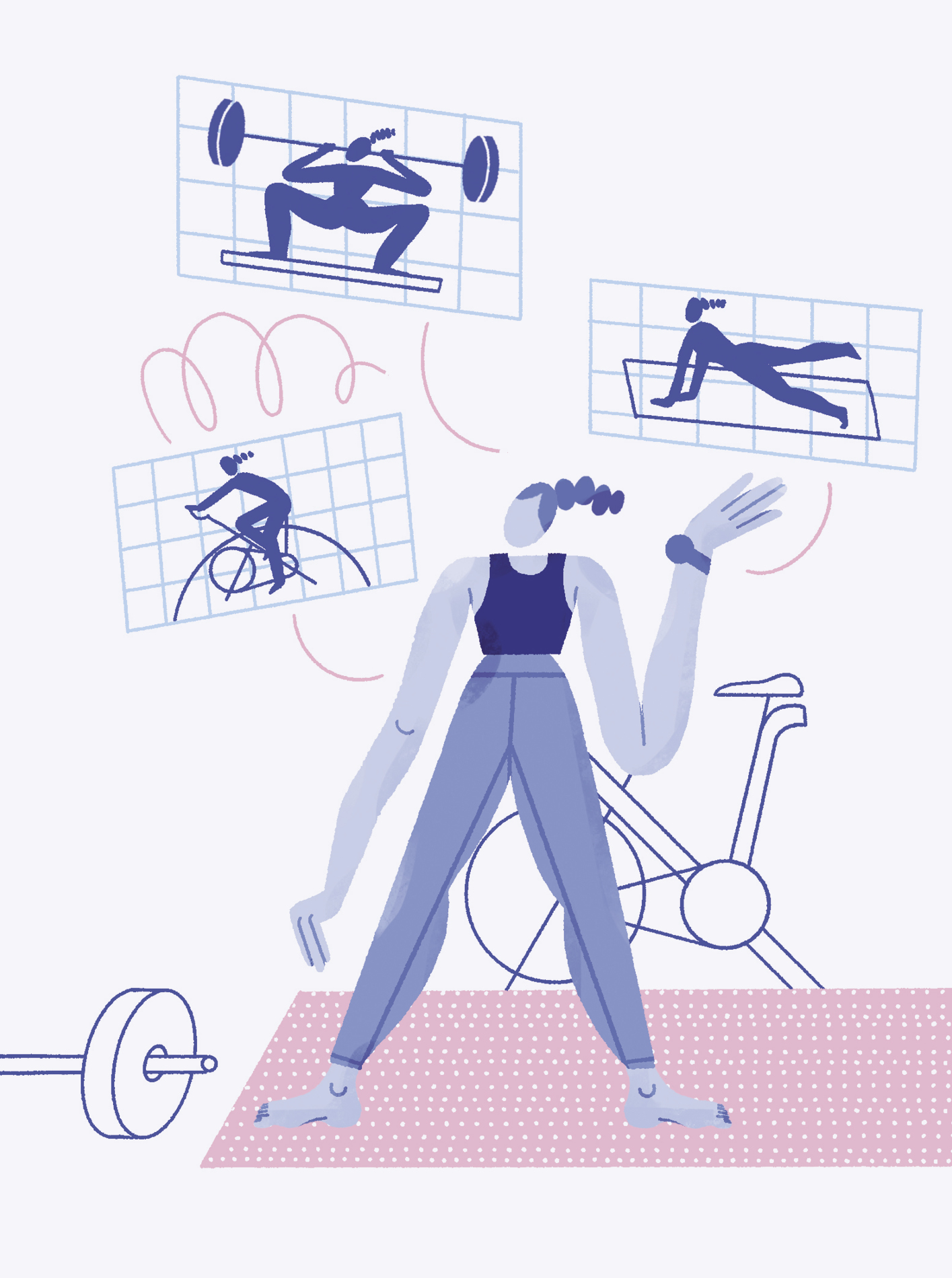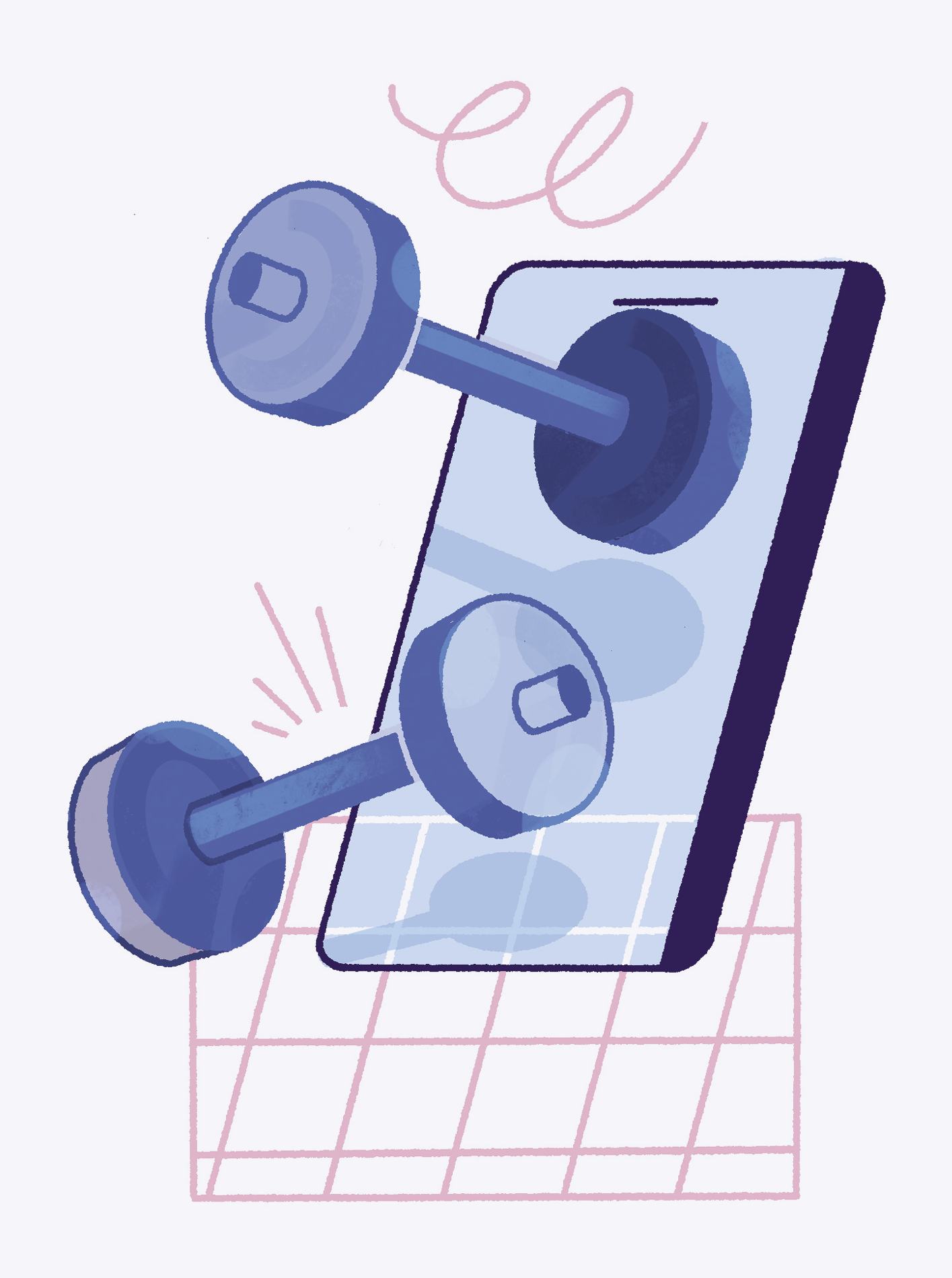WORDS
Jamie Millar
ILLUSTRATION
Frederique Matti
RIDE ALONG
US President Joe Biden and Beyoncé run the world, but they also cycle on the spot as two of the 3.6m global members of workout phenomenon Peloton. To paraphrase Lance Armstrong, it’s not just about the touch-screen-equipped stationary bike that – with its stylish design and fan-base of high achievers – had transmuted home workouts from “no better option” to aspirational lifestyle choice even before the pandemic reverted them to needs must again. Nor is it about the equally stylish treadmill, or even the shiny new Bike+ that automatically adjusts your resistance and cadence on your instructor’s say-so. (Don’t worry, it’s an option.) No, the real USP of the so-called “Netflix of fitness” is the quantity and broadcast-quality of its live and on-demand content, encompassing everything from strength and boot camp to yoga and meditation (the screen of the Bike+ swivels for ease during floor work). Not to mention the community and competitiveness fostered by the leader boards and virtual high fives. You can subscribe to the content via Peloton’s app without investing in its high-end hardware, but in tandem they provide a seamless, studio-like experience that ensures a healthy return.
Bike from £1,750, treadmill and Bike+ from £2,250, monthly subscription £39; onepeloton.co.uk

ROW THE DISTANCE
If you’re considering splashing out on a statement piece of home workout equipment, there’s a strong argument in favour of a rowing machine, as it offers a full-body workout that combines resistance and cardio in one supremely taxing whole. And it can’t be denied that there are more aesthetically pleasing examples of the form extant. But if you’re more concerned with getting fit than fitting your decor then Concept 2 is the unalloyed gold standard: it created the first-ever rowing “ergometer” in 1981 as a training aid for athletes and remains the number one choice of discerning sportspeople to this day. A step up on the Model D, the world’s most popular rowing machine found in every gym worth its sodium, Concept 2’s flagship Model E is slightly taller for easier mounting and dismounting, plus more durable and, daresay, handsome with its double powder coat. While perhaps lower-tech than some of the other entries here, the Model E comes with a performance monitor that can connect to heart-rate chest straps and other wearables and, in conjunction with an app, charts your progress. And thanks to its quick-release framelock mechanism, you can easily separate it into two pieces for storage.
£1,060; concept2.co.uk
ELITE DIY MASSAGE
Nobody knew they needed a “percussion massage device” before Therabody, née Theragun, a rebrand that reflects its expansion into CBD balms but also sounds rather more soothing. And comparisons to a power tool with a rubber attachment – which is what the original prototype jury-rigged by founder and chiropractor Dr Jason Werland to relieve his own muscle pain following a motorcycle accident – can strike as less than enticing. But trainers, professional athletes and almost anybody else who tries it will loudly bang the drum for Therabody, which has become the Hoover of the booming percussion massage device category – or, more accurately, given its sleek looks and covetable-ness, the Dyson. What Therabody’s devices might lack in bedside manner compared with your regular bodywork practitioner, they compensate for in always-onhand availability and sheer mechanical efficiency, vibrating 40 times per second. Administering DIY massage is made relatively painless by an app that connects to Apple Health and Google Fit to gauge your activity and suggest appropriate guided routines. The Elite is Therabody’s quietest model, giving your neighbours relief when you’re easing the tension of a hard workout of an evening.
£375; theragun.com

PACK A PUNCH
For the sensation of being taken out of your home – and fully immersed somewhere else entirely – it’s hard to beat virtual reality boxing and dancing. Designed to work with the standalone, user-friendly Oculus Quest headset or various peripherals that connect to your PC or PlayStation 4, FitXR is like something out of the film Tron or an amalgam of Wii Fit Boxing, Guitar Hero and Dance Dance Revolution. (Delete according to your age and degree of computer game literacy.) From the lobby of a virtual fitness facility, you select your class of choice from TV screens. Boxing consists of throwing punches in time with the music in order to hit targets that fly towards you, your handsets vibrating to register the impacts, while bobbing and weaving to avoid incoming barriers, with accuracy and power reflected in your score. More conventionally, dancing sees you follow along, or at least try to, with moves demonstrated by a digital instructor. (All the classes are programmed by analogue trainers with real credentials.) Serious exercisers may regard FitXR as nothing more than a bit of fun, if surprisingly demanding, but recreational ones might find they get hooked.
Monthly subscription £22.99 (Oculus Quest £534.99); fitxr.com
KEEPING TRACK
Golfer Nick Watney had no idea he was infected with Covid-19 until he checked his Whoop fitness tracker one morning and saw a big swing in his breathing rate while sleeping. Shortly after, the PGA Tour procured 1,000 of the devices for the rest of its golfers – some of the few top athletes yet to adopt Whoop, which had carved a niche in the crowded field of wearables as a powerful tool for the likes of LeBron James and Michael Phelps to drill down into their performance metrics. If anything, Whoops’s data was too rich for mass consumption, but this latest iteration makes that a little more digestible. Mercifully, there’s no display on, or distracting notifications from, the elegant wrist strap, which is minimally designed and waterproofed to be worn at all times. Instead, log into the app for all the numbers you can crunch, including strain and recovery scores based on factors such as sleep and heart rate variability (tiny fluctuations that are a marker of your overall stress level). Forearmed thusly, you can determine how intensely to train, if at all, and broadcast your workout stats on social media in real time. The only variety of overload you’ll be risking is informational.
Monthly subscription £30 (including strap, minimum six months), 12 months £288, 18 months £324; whoop.com

BRING THE GYM HOME
If you frequent fitness studios and want a facsimile of their vibe, but not a bulky machine interfering with your feng shui, you might recognise some of Fiit’s instructors, who are among the best, and best-known, on the London circuit. Fire up the app on your phone or tablet, or your TV via Sky Q or the adaptor supplied, and take your pick of strength, cardio or “rebalance” (yoga, Pilates, mobility and breathwork). No equipment is required, although a mat is recommended, and if you own dumbbells, kettlebells or resistance bands then some of the more than 600 classes will put them to good use. If you don’t own an Apple Watch, Fitbit or other compatible wearable, meanwhile, you can purchase an assortment of chest straps from Fiit’s online shop to show your heart rate, calorie burn and rep count. If that isn’t enough to fire you up then the app will tell you if you’re in the required heart-rate zone, award you Fiit points for effort (the fitter you are, the harder you have to try) and, during live classes, display your leader board position; sign up for training plans and challenges to keep you coming back – and off the couch.
Monthly subscription £20, three months £45, 12 months £120, Fit Device Lite £25; fiit.tv
RATE YOUR METABOLISM
A first-of-its-kind home metabolism tracker – or, if the claims are to be believed, “hacker” – Lumen is the bright idea of Michal and Mirav Mor, twin sisters, physiology PhDs and Ironman triathletes, and endorsed by Tour de France winner Chris Froome. Previously, finding out whether you were metabolising predominantly carbohydrates or fat necessitated a visit to a laboratory. Now, you can simply exhale into this vape-like unit, which measures the concentration of carbon dioxide in your breath and tells you via the accompanying app, which also recommends your total intake of fat, carbs and protein based thereupon. If you’re still burning off dinner from the night before, low-carb might be the order of the day. Or an extended period of running on fat could be carte blanche to eat more carbs, so you don’t start stockpiling instead of metabolising them. Before a workout, you can check whether you’re adequately fuelled; after, how your metabolism has been affected. A month of huffing and puffing will reveal your “metabolic flexibility”: how well you switch between carbs and fat. Lumen’s promises for health, weight management and performance are tantalising. But if nothing else, it should make you mindful of what you’re putting in your mouth.
£349; lumen.me

SIMULATE YOUR ROUTE
If you’re a “real” cyclist or runner, then virtual training app Zwift is the next best thing to getting out on the road or trail. Rather than recreate the feel – and four walls – of a studio, Zwift simulates al fresco environments populated by other people, mapping your output to the progress of your avatar, so you can enjoy the views and company while you’re suffering the hills. You can ride or run with or against friends or randoms: last year, the first-ever virtual Tour de France took the place of the postponed IRL event on the calendar and broadcast schedules, with pros racing across versions of some of the iconic stages – and the volcanoes of “Watopia”. Some static bikes, such as the Wattbike Atom, will work, but Zwift is really geared for road ones hooked up to a turbo trainer – ideally a smart one that automatically adjusts the resistance. Add a grade simulator to lift you up and down, even a smart fan for wind in your face. Zwift can’t yet control your treadmill’s elevation, but the upside is you can pair it with any Bluetooth model or attach a “Runpod” to your laces and be running alongside – or way behind – the likes of Sir Mo.
Monthly subscription £12.99, Runpod £29.99; zwift.com





